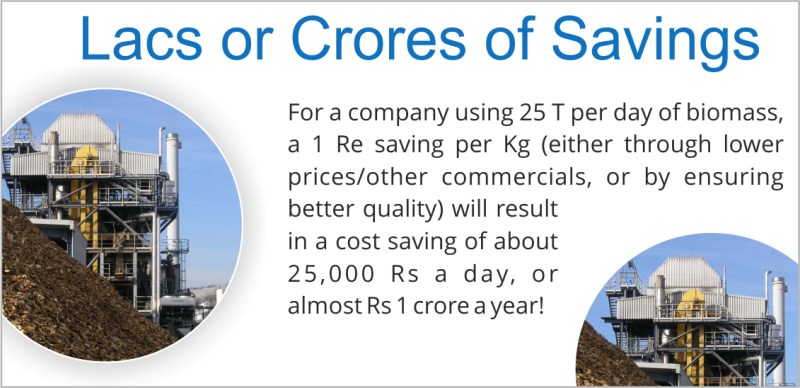
EAI’s BioMetric Helps You Cut Costs and Improve Biomass Quality

Thousands of Indian companies use biomass for heating or for power generation. Some of them use over 25 T per day, and a few among these use over 100 T per day But the biomass supply chain in India is highly unorganized, with few metrics and benchmarks available Until now, there have been no benchmarks or metrics available to companies to measure the above.
Case Studies
Not
anymore
EAI’s BioMetric is India’s first biomass benchmarking solution that enables you to analyse your biomass supply chain in a powerful manner. And arrive at decisions on feedstock and prices that will result in significant cost savings and operational efficiency

EAI’s BioMetric is a well thought out solution that will provide excellent insights on your current biomass supply chain and clear action points on how you can optimize various components of your supply chain for better results.
The entire solution takes just 3 weeks from start to finish.
Get to know more.
Download our Biomass Strategy Consulting brochure
 Download
Download
EAI BioMetric Steps & In sights

Interactions with Your Procurement Team
EAI’s bio-energy consultants will interact with your procurement team to gather details of your biomass and supply chain – biomass characteristics, number of vendors, vendor profiles, prices and commercial terms, end-use details for biomass etc.Some of the Biomass feedstock, our team has worked with, include – Saw dust, Groundnut shell, Rice husk, Bagasse pith, Coir pith, Mustard stalk, sugarcane waste, cotton stalks, coffee husk, coffee waste etc.

Benchmarking Your Existing Biomass Supply Chain Data with the Best
Using our existing database of biomass supply chain data points from around the country, and specifically those in your region, our solution will benchmark your supply chain details against what should be an ideal supply chain. Such benchmarking will happen for both quantitative and qualitative parameters.

Identifying Areas for Improvement from the Benchmark Analysis
The above Benchmarking Analysis will result in an Optimization Matrix that highlights gaps in your biomass supply chain and points out possible optimizations.

Devising the Optimal Biomass Supply Chain and Procurement Strategy
With the Optimization Matrix, EAI’s bio-energy consulting team will once again interact with your procurement team, and in select cases along with your vendors, to chart out the most optimal biomass supply chain strategy. Such a strategy will result in inferences on the following, among others
The following are the states where we have provided assistance:
- Tamil Nadu
- Andhra Pradesh
- Telangana
- Karnataka
- Maharashtra
- Gujarat
- Punjab
- Haryana
- West Bengal
- Kerala
Some of the Biomass feedstock, our team has worked with, include : Saw dust, Groundnut shell, Rice husk, Bagasse pith, Coir pith, Mustard stalk, sugarcane waste, cotton stalks, coffee husk, coffee waste etc.
Learn more about our BioMetric work – Download this PDF now
Get in touch with our consulting team by sending brief details of your requirements and profile
Kindly send the details to – consult@eai.in or call Muthu 9952910083
Please note that the EAI BioMetric services are available only to those commercial or industrial units who consume at least 25 T of biomass per day.
Case Studies of companies shifting from natural gas to Biomass for heating

Read on to find all the basics of biomass briquetting.
Biomass densification through briquetting: The what?
Biomass is the organic material of recently living plants from trees, grasses and agricultural crops. Unlike fossil fuels which are main driving force behind climate change, biomass can be a be a source of renewable and carbon-neutral energy. It has become an important source of energy to meet the international emission reduction goals, along with other renewable energy technologies. It is the third largest energy resource in the world, behind coal and oil.
Biomass was the first source of energy that mankind learned to use. Right until the mid-19th century, biomass dominated global energy consumption. Once coal began finding major use as a source of heat and electricity, the share of biomass reduced. Recently, the share of bioenergy is gradually increasing [4]. In 2012, the total bioenergy supply was over 51 EJ, comprising some 10% of the total world’s energy supply. An estimated 50% of this biomass energy, in the form of fuel wood or charcoal, is consumed in developing countries for heating and cooking with a very low efficiency (reference in 4), some 10-20%, while modern biomass use for electricity production currently supplies 1.5% of the electricity demand on a global scale, corresponding to about 280 TWh of electricity [4]. Today’s overall efficiency of biomass-based combined heat and power (CHP) plants for industry or district heating ranges from 70%-90% (reference in 4).
The least-expensive biomass resources are the wood residues/waste from forestry and industry, and agricultural residues, but also their supply is limited, e.g., wood residues is also used for heat production in paper and pulp industry [2]. To overcome this limitation, countries around the world are considering biomass crops for energy purposes (called energy plantations) and have begun developing technologies to use biomass more efficiently. Most countries have now adopted the practice of energy plantations. According to a World Energy Council report from 2005, Brazil at that point was using 3 million ha of eucalyptus plantations for charcoal making; China had a plantation program of raising 13.5 million ha of fuel wood by 2010; and Sweden was using about 16,000 ha of willow plantations for heat and power generation. Till 1992, an area of 17,000 ha had been brought under energy plantations in India.
One of the major limitations of biomass for energy purposes is its low bulk density, typically ranging from 80–100 kg/m3 for agricultural straws and grasses and 150-200 kg/m3 for woody biomass, like wood chips. The low bulk densities of biomass often make the material costly to store, transport, and use. Low bulk density also presents challenges for technologies such as coal cofiring, because the bulk density difference causes difficulties in feeding the fuel into the boiler and reduces burning efficiencies. Further, high moisture content in the biomass makes transportation and storage inefficient. Densification is used to overcome these limitations. During densification, biomass is mechanically compressed, increasing its density about ten fold. Commercially, briquetting is a commonly used methods for densification; another common method is pelleting. There are different densification technologies, including pellet mills, screw press, piston press, and roller press [1].
In the biomass briquetting process, the material is compressed under high pressure and temperature. The biomass particles self-bond to form a briquette due to thermoplastic flow. Lignin (it is one of the main constituents of biomass; the other important constituents are cellulose and hemicellulose), which is a natural binder, is made available from high temperatures and pressures resulting in the formation of high-density briquettes. The dense briquette is a clean fuel that can be used in boilers (to generate steam for power generation), furnances (to heat a feed), or open fires.
Briquetting: The why?
Biomass briquettes helps in the following way: ease of charging the furnace, increased calorific value, improved combustion characteristics, reduced entrained particulate emissions, and uniform size and shape. In addition, furnaces that use other solid fuels can use briquettes also.
One main disadvantage of using biomass briquettes (or pellets) in industrial furnaces or boilers over other solid fuels is ash slagging due to the alkali content in briquettes made from biomass.
Comparision with pelleting: Briquette processing is more efficient than pelleting because the biomass materials do not necessarily have to be preprocessed or uniformly ground up, which results in less preparation. Another advantage of briquetting is it can be set onsite. Briquetting waste byproducts and reusing them onsite for energy rather than transporting them to another location or to a landfill can save on disposal costs. Briquetting generally uses less horsepower. From the investment point of view, the purchase capital and maintenance costs to make briquettes are less than for pellets. Pellets have been considered more of a residential fuel even though they are used in some larger, commercial applications. If transportation is one of the main criteria, pellets are more advantageous because there are more kilograms per unit volume than briquettes. This is especially true if the briquettes are larger because it allows for more air between them when they are stacked.
Technologies and their comparisions
Briquetting is carried out using a screw press or a piston press. (Screw press is also used for pelleting.) It is widely accepted that briquettes from a screw press are have far more superior combustion and storage qualities than briquettes from a piston press [3].
Screw compaction or extrusion
In screw compaction (or screw extrusion), the material is taken in from the feed port, moves through a barrel with the help of a rotating screw, and is finally extruded against a die, which builds a large pressure gradient along with screw. The die can be tapered, which further compacts the biomass. Along with high pressure, frictional effects increase the temperature of the biomass. The die is also usually heated externally for making the biomass pseudo-plastic for smooth extrusion.
A screw press being used for pelleting [1]
Compaction mechanism
As the biomass enters through the feed section, and is compacted a little. In the compression zone, formed by a tapering barrel, friction at the barrel wall and between the particles of the biomass, along with a high rotational speed (~ 600 rpm), causes the temperature to increase to 200–250 °C. The high temperature and pressure softens the biomass turning it plastic, The particles get pressed against each increasing the intermolecular forces. In this respect, lignin plays an important role by acting as a natural binder. At elevated temperatures (>140 °C) and pressure, lignin melts and forms solid bridges between particles. as Finally, in the tapered die, temperature further increases to 280 °C. Steam gets removed and further compaction takes place. Pressure is transmitted uniformly through the biomass create a uniformly dense briquette.
Merits of screw compaction
Continuous output, uniform briquettes, concentric hole formed in the briquette helps in better compaction because of air circulation during combustion, machine runs smoothly without shock load, machine parts and oil are free of raw material compaction, and the outer surface of briquette is partially carbonized (which facilitates ignition and combustion, and also protects briquettes from ambient temperature). Compared to the piston press (which is discussed below), the briquette quality and production process of a screw press.
Demerits
Power requirements are high compared to piston press. Also, screw press parts, like the ram and die, require more maintenance compared to the piston press.
Piston press
Apart from screw extrusion, a birquette press is a viable and attractive solution. As already mentioned, it has lower power requirement. Unlike pellet mills (which are used for pelletization), it can handle larger-sized particles and wider moisture contents without the addition of binders. Hydraulic or mechanical presses are usually used. The briquettes’ densities generally range from 900 to 1300 kg/m3.
Mechanical piston press
Mechanical piston presses are typically used for large-scale production, ranging from 200 to 2,500 kg/hr. The mechanical press is designed as an eccentric press. A continuously rotating eccentric, connected to a plunger, presses the raw material through a conic die. In mechanical presses, the counter pressure required can only be adjusted by mounting a die with a different conicity. The mechanical press is driven by electric motors instead of a hydraulic motor. Energy loss in the machine is limited, and the output in relation to power consumption is optimal. The operating life of a mechanical press is considerably longer than hydraulic presses. Generally, a mechanical press gives a better return on investment than a hydraulic press.
Hydraulic piston press
Hydraulic piston presses are commonly used as briquetting machines for densification of biomass. The energy to the piston is transmitted from an electric motor via a high-pressure hydraulic system. The output of a hydraulic press is lower, since the movement of the cylinder is slower compared to mechanical processes. The briquettes have a bulk density lower than 1000 kg/m³ because pressure is limited to 40–135 kg/h. However, these machines can tolerate higher moisture contents than the usually accepted 15% for mechanical piston presses (www.cfnielsen.com). To improve the production capacity, some continuous briquetting presses are available commercially.
A note on biomass power generation technologies
Before in the coming sections, we take a look at all the different factors involved in the biomass supply chain that includes briquetting, it is first worth noting what are different power generation technologies using biomass. Power generation from biomass can be achieved with a wide range of feedstocks and power generation technologies that may or may not include an intermediate conversion process (e.g. gasification). In addition, different feedstocks and technologies are limited or more suited to different scales of application, further complicating the picture.
Bioenergy can be converted into power through thermal-chemical processes (i.e. combustion, gasification and pyrolysis) or bio-chemical processes like anaerobic digestion. Thermo-chemical processes include combustion, gasification and pyrolysis. Solid fuel combustion is a commercially proven technology with a wide range of technology suppliers. Gasfification on the other hand has only very recently started being deployed at commercial scale.
Biomass combustion
It can be applied on a wide range of scales from a few MW to 100 MW or more and is the most common form of biomass power generation. In fact around the globe , more than 90% of the of the biomass that is used for energy purpose goes through this route. Feedstock availability and costs have a strong influence on project size and economics, since with increasing scale the increased transport costs for the biomass feedstock may outweigh economies of scale from larger plants. However, this is also very project-specific [2].
There are two main components of a combustion-based biomass plant: 1) the biomass-fired boiler that produces steam; and 2) the steam turbine, which is then used to generate electricity. The two most common forms of boilers are stoker and fluidised bed. These can be fuelled entirely by biomass or can be co-fired with a combination of biomass and coal or other solid fuels. Stoker boilers burns the fuel on a grate generating hot flue gases that is then used to produce steam. Fluidized bed boilers suspends fuels on upward blowing jets of air during combustion. Fluidized bed boilers can be a more effective way to generate electricity from biomass with a higher moisture content than typical in a stoker boiler.
Feedstock for briquetting
There are a variety of biomass sources, which include residues from forestry, wood from energy plantations, agricultural residues (which can be field based, like stalks and straws, or process based, like rice husk and bagasse), organic waste from industries like pulp and paper industry, food processing industry and sugar industry, municipal solid waste (MSW) and animal waste (like animal dung and poultry litter),
The quality and sustainability of the biomass feedstock is critical to a biomass power generation project’s economics and success.
Biomass feedstocks are very heterogeneous (which can become a problem if the combustion technology requires a homogeneous feedstock) and the chemical composition is highly dependant on the plant species. Understanding some of the major chemical compositional changes that take place during processing of biomass is useful in understanding what process variables, like temperature, pressure, die geometry, and mechanisms of densification, are suitable. Changes in these variables will bring about significant changes in the chemical compositions of the biomass by mechanisms known as interaction reactions, which determines quality parameters, such as moisture content, bulk density, and durability of densified biomass. Some of chemical constituents of importance are like starch, cellulose, hemicellulose, fat, and lipid.
Some crucial factors for the biomass feedstock are: energy, ash and moisture content, and homogeneity. These will have an impact on the cost of biomass feedstock per unit of energy, transportation, pre-treatment and storage. These are discussed next.
Particle Size
Compared to pelleting, briquetting requires larger particle sizes. Particle size greater than 6 mm are suitable as it leads to interlocking of particles and creates more durable briquettes [1]. A screw press employs higher pressure and can handle larger particle size, but sizes much larger than 6 mm will clog the press at the entry point as large particles accumulate near the feeder and jam the barrel [3].
Moisture content
Moisture plays a critical role in biomass densification. An optimum moisture content can decide the success or failure of the densification of biomass. Moisture improves the bonding between particles by increasing the van der Waals’ force (reference in 2). Further, the high temperatures and pressure achieved during briquetting along with the moisture increases lignin melting, helping to improve the binding characteristics. However, at higher than optimum moisture content will produce briquettes which are weak and poor, and the briquetting operation is erratic. Excess steam gets produced leading to the blockage of incoming feed from the hopper, and sometimes briquettes shoot out from the die [4].
Reference 4 states that for a piston press, the optimum moisture content is 10-15%, whereas for a screw press, it is 8-9%.
Ash content and slagging
An important consideration for feedstocks is the ash content, as ash can form deposits inside the combustion chamber, called “slagging” and “fouling”, which can impair performance and increase maintenance costs.
Slagging occurs in the boiler sections that are directly exposed to flame irradiation. Slagging deposits consist of an inner powdery layer followed by deposits of silicate and alkali compounds. Fouling deposits form in the convective parts of the boiler, mainly due to condensation of volatile compounds that have been vaporised in previous boiler sections and are loosely bonded. Slagging and fouling can be minimised by keeping the combustion temperature low enough to prevent the ash from fusing. Alternately, high-temperature combustion could be designed to encourage the formation of clinkers (hardened ash), which could then be more easily disposed of.
Grasses, bark and field crop residues typically have higher amounts of ash than wood. Compared to other biomass, rice husk has notably high ash content (silica), 20%, and it needs special combustion systems for ash removal.
Particle size and distribution
Particle size is an important parameter that influences durability. Finer particles accept more moisture and, therefore, undergo a higher degree of preconditioning. Preheating or steam conditioning of the feed normally increases the activity of inherent binders like starch.
Medium or fine-ground materials are desirable for densification because, at these sizes, they have greater surface area for moisture addition during steam conditioning, which results in increased starch gelatinization and better binding. A certain percentage of fine to medium particles maybe required for better densification. Absence of coarse particles in the feed or biomass mix will significantly affect the production efficiency of commercial pellet mills. There is a critical particle size below which the pelletization is not commercially feasible in terms of technical ability and economics of pellet production.
Quality of briquetted biomass
Quality attributes of the densified biomass play a major role in the end-user applications, that is combustion etc.. The quality of the densified biomass depends upon the feedstock composition, which includes starch, protein, fiber, fat, lignin, and extractives; feed moisture content; feed particle size and distribution; feed conditioning, temperature/preheating of feed; and densification equipment variables (the pressure, temperature, and die geometry and speed). All these will significantly affect the strength and durability of the densified products. The quality will determine whether the densified biomass can withstand the compressive, impact, and water resistance during storage and transportation.
Moisture content
The final moisture content of the pellets or briquettes from biomass is greatly dependent on process conditions like initial moisture content, temperature, and pressure. Higher moisture content in the final product results when the initial moisture content is greater than 15%. According to one observation [1], moisture content of >15% and pressure >15 MPa has a negative effect on the final briquette quality as cracks were observed. Low moisture content will also lead to revenue loss to the manufacturer as the densified biomass becomes fragile, creating more fines during storage and transportation.
One study [1] that researched the compaction of tree bark, sawmill waste, wood shavings, alfalfa hay, fresh alfalfa, and grass in a piston press found that an optimum moisture content of approximately 8% was recommended to produce high-density briquettes. It also recommended a moisture content range of 5–12%.
Unit density & bulk density
Briquettes with higher unit and bulk density are preferred as fuel because of their high energy content per unit volume, important from the point of view of storage and transportation, and slow burning property. These parameters are greatly influenced by the feedstock’s moisture content and particle size, and the process pressure and temperature.
Percent fines
Densification under suboptimal conditions (e.g., at lower temperature, lower moisture content, and with less desirable chemical compositions, or with insufficient die size and roller speed) will result in more fines in the final product. Fines are generated during transportation and storage by the breakdown of the densified product. Their presence is not desirable, especially when cofiring with other fossils fuels in the boiler. Also, once they cross the storage threshold value in silos, they can can aggravate dust explosion and spontaneous combustion problems.
Durability
The durability index is a quality parameter defined as the ability of densified materials to remain intact when handled during storage and transportation. Durability or abrasive-resistance measurements help to simulate either mechanical or pneumatic handling forces, and control the feed quality. Different types of equipment (Holmen tester, tumbling can, Ligno tester, and Dural tester) are used to test durability.
Summary of the life cycle economics
Consideration of the life cycle from a biomass source to briquetting to an industrial end user (boiler or furnace) clarifies the various components of cost in using biomass as an energy source. The first component of the cost for an end user is the price of buying biomass from the source (rural or urban). In some cases, biomass is an opportunity for waste disposal, so there is no cost added at this stage. Another component of the cost the process of briquetting (along with any preprocessing) itself. Transport, both from biomass source to the briquette manufacturer and from there to the industrial end user, adds a significant amount to the briquette cost for the end user. To take transport costs properly into consideration, it is therefore not just important to consider the price of briquettes on a mass basis (when comparing different manufacturers), but also the price on a energy basis (that is, Rupees per unit of energy). Hence the Gross Calorific Value (GCV) of the briquette and the transportation distance can make or break the business case for using briquettes from a particular manufacturer. As explained above, moisture content in the briquette is an important factor that determines the energy density. In India, a distance of more than 100-150 km becomes unreasonable.
To end, an industrial end user, who wants to source briquettes for either heat and/or power , needs to consider the following:
- the capacity of the manufacturer,
- the quality of the briquette (conversely, what process is used for densification),
- the commitment of the manufacturer (total investment plunked, in aspects like fire safety, presence of a warehouse, availability of own logistical facilities)
- distance of the manufacturer